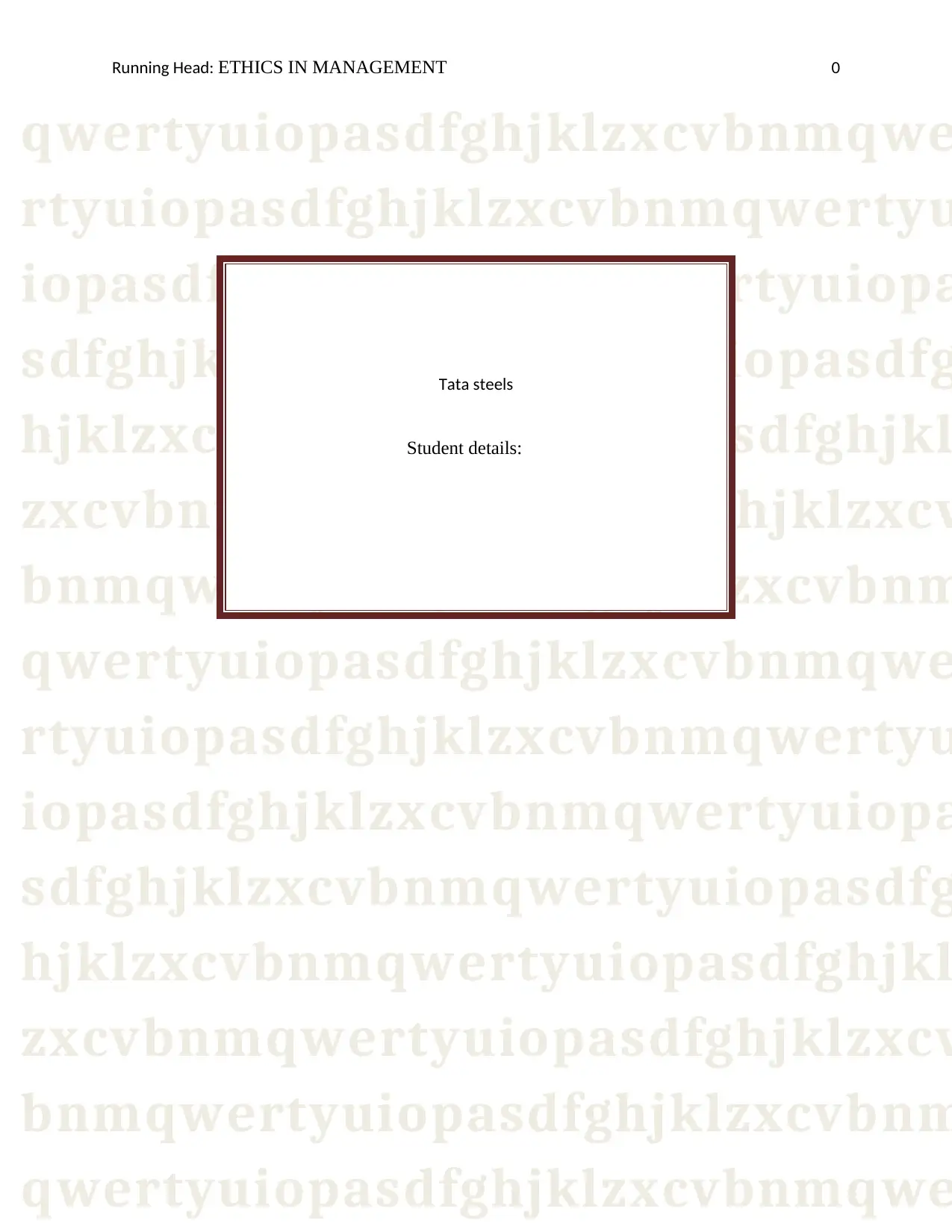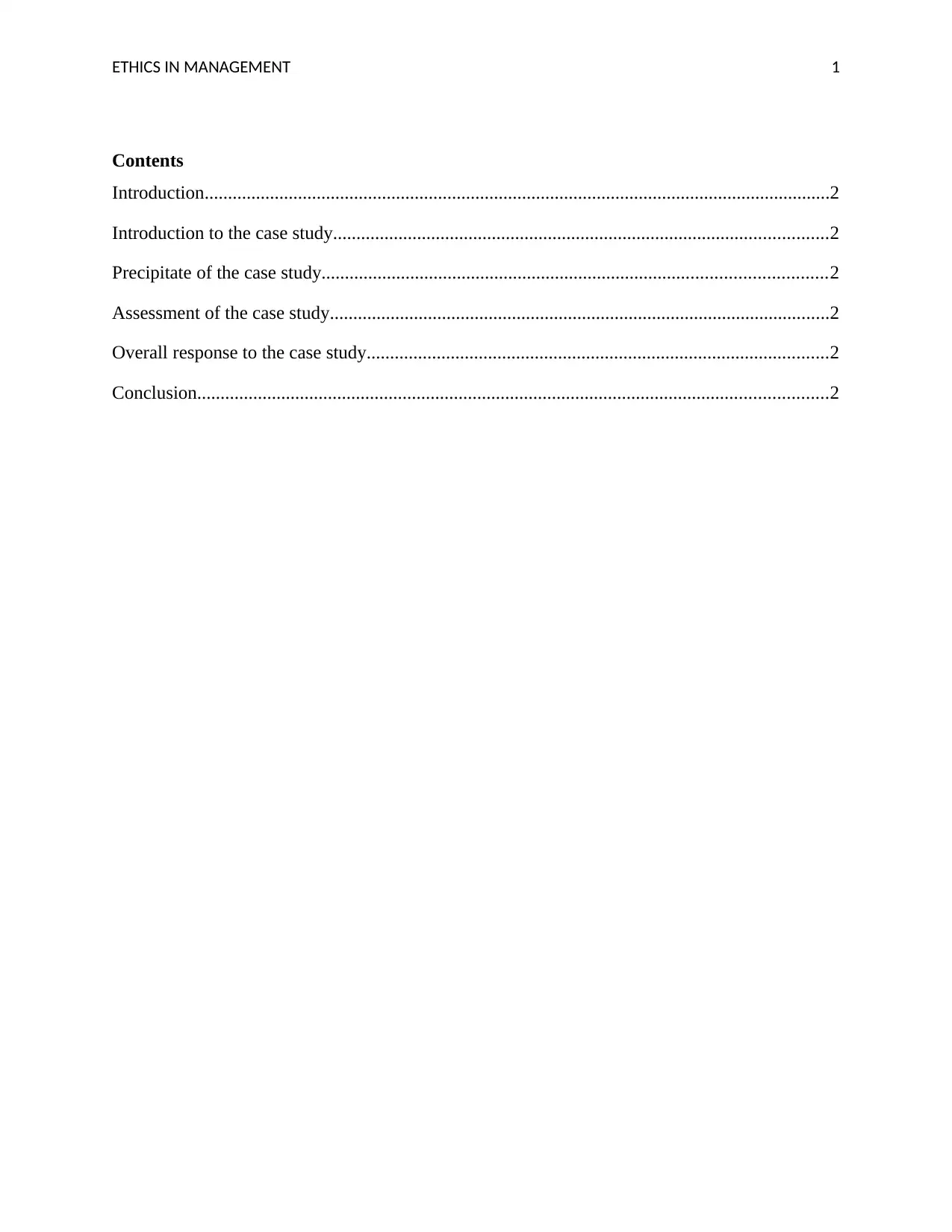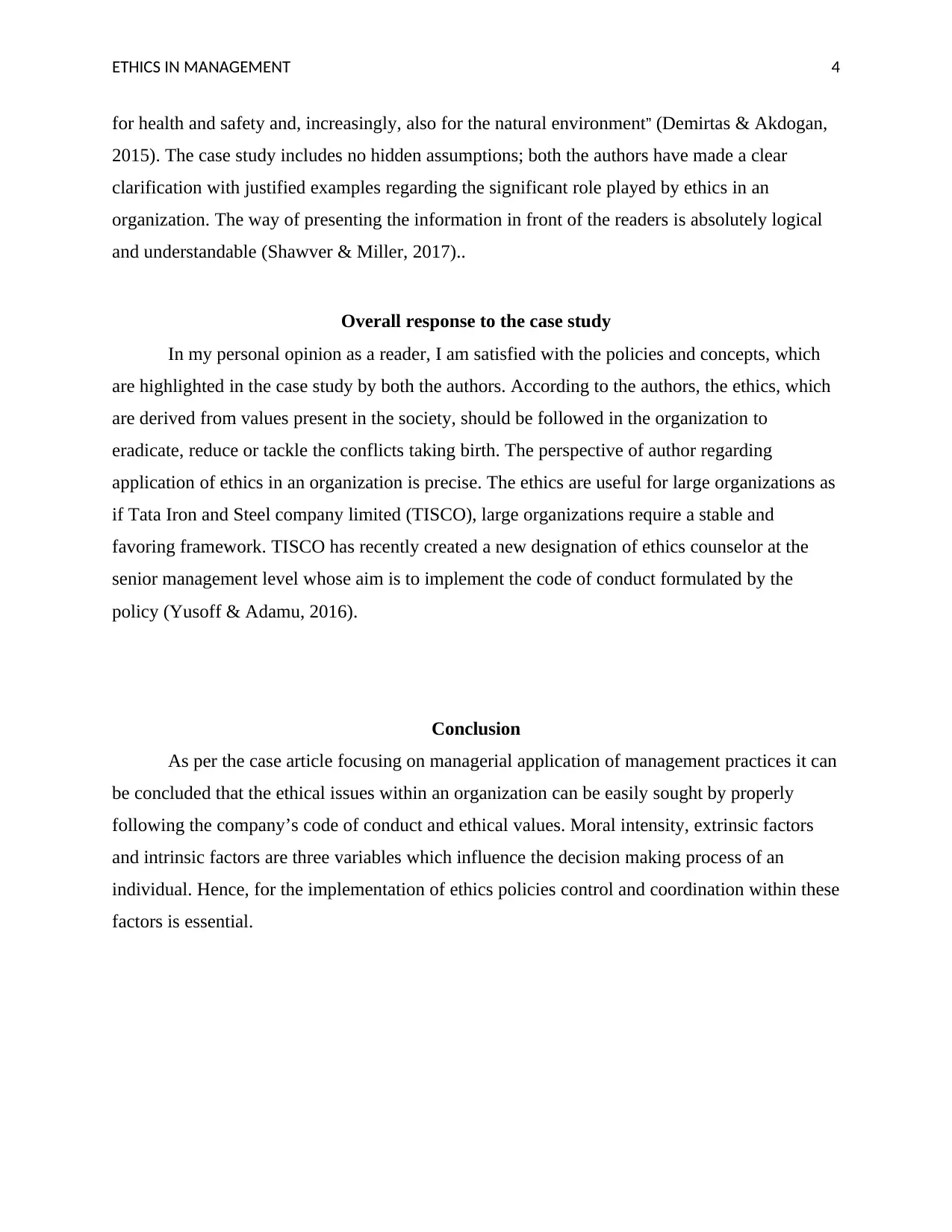Case Study: Ethics and Management Practices at Tata Steel
VerifiedAdded on 2022/10/06
|6
|1342
|38
Report
AI Summary
This report analyzes the case study of Tata Iron and Steel Company Limited (TISCO), focusing on ethics in management. It explores the company's ethical framework, including intrinsic and extrinsic factors, and moral intensity in decision-making. The report summarizes the case study, highlighting the importance of ethics in organizational functioning and the impact of ethical values on stakeholders, shareholders, and managers. It assesses the clarity, accuracy, and relevance of the case study, emphasizing the framework for ethical decision-making. The report also discusses the variables influencing ethical decision-making, such as moral intensity, intrinsic, and extrinsic factors. It concludes that ethical issues can be addressed by following the company's code of conduct and ethical values, and emphasizes the importance of controlling and coordinating these factors for effective implementation of ethics policies. The report references the original case study by Maheshwari and Ganesh, and other related academic sources to support its analysis.

qwertyuiopasdfghjklzxcvbnmqwe
rtyuiopasdfghjklzxcvbnmqwertyu
iopasdfghjklzxcvbnmqwertyuiopa
sdfghjklzxcvbnmqwertyuiopasdfg
hjklzxcvbnmqwertyuiopasdfghjkl
zxcvbnmqwertyuiopasdfghjklzxcv
bnmqwertyuiopasdfghjklzxcvbnm
qwertyuiopasdfghjklzxcvbnmqwe
rtyuiopasdfghjklzxcvbnmqwertyu
iopasdfghjklzxcvbnmqwertyuiopa
sdfghjklzxcvbnmqwertyuiopasdfg
hjklzxcvbnmqwertyuiopasdfghjkl
zxcvbnmqwertyuiopasdfghjklzxcv
bnmqwertyuiopasdfghjklzxcvbnm
qwertyuiopasdfghjklzxcvbnmqwe
Running Head: ETHICS IN MANAGEMENT 0
Tata steels
Student details:
rtyuiopasdfghjklzxcvbnmqwertyu
iopasdfghjklzxcvbnmqwertyuiopa
sdfghjklzxcvbnmqwertyuiopasdfg
hjklzxcvbnmqwertyuiopasdfghjkl
zxcvbnmqwertyuiopasdfghjklzxcv
bnmqwertyuiopasdfghjklzxcvbnm
qwertyuiopasdfghjklzxcvbnmqwe
rtyuiopasdfghjklzxcvbnmqwertyu
iopasdfghjklzxcvbnmqwertyuiopa
sdfghjklzxcvbnmqwertyuiopasdfg
hjklzxcvbnmqwertyuiopasdfghjkl
zxcvbnmqwertyuiopasdfghjklzxcv
bnmqwertyuiopasdfghjklzxcvbnm
qwertyuiopasdfghjklzxcvbnmqwe
Running Head: ETHICS IN MANAGEMENT 0
Tata steels
Student details:
Paraphrase This Document
Need a fresh take? Get an instant paraphrase of this document with our AI Paraphraser

rtyuiopasdfghjklzxcvbnmrtyuiopa
ETHICS IN MANAGEMENT 1
Contents
Introduction......................................................................................................................................2
Introduction to the case study..........................................................................................................2
Precipitate of the case study............................................................................................................2
Assessment of the case study...........................................................................................................2
Overall response to the case study...................................................................................................2
Conclusion.......................................................................................................................................2
ETHICS IN MANAGEMENT 1
Contents
Introduction......................................................................................................................................2
Introduction to the case study..........................................................................................................2
Precipitate of the case study............................................................................................................2
Assessment of the case study...........................................................................................................2
Overall response to the case study...................................................................................................2
Conclusion.......................................................................................................................................2

ETHICS IN MANAGEMENT 2
Introduction
The following report based on the case study of Tata Iron and Steel Company Limited
(TISCO), India. The report highlights ethics, which should be followed in an organization.
Initially the report introduces author and gives a brief about the case. The report includes a
precipitated summary of the case study, which revolves around the intrinsic factors, extrinsic
factors and moral intensity used for decision-making and behavior in Tata steels. Later it
evaluates the ideas proposed by author regarding the decision-making ethics and assesses the
clarity in language used by the author, fairness and defining the key terms. “Ethics in
Organization is a case study of Tata Steels” gives detailed information about Tata Steel one of
the oldest companies in India, it was established in 1907 by Jamshed ji Tata (Maheshwari &
Ganesh, 2006). TISCO is India’s first and biggest private steel manufacturing company. The
following case study is presented by Sunil Kumar Maheshwari and M. P. Ganesh. Herein, both
the authors have made a strong clarification on the theories, concepts and practices of
management used by organizations (Ngang & Chan, 2015). According to them, the concern of
managers, social groups and regulators is aimed at ethical decision- making. In their work,
authors have made efforts to develop a comprehensive framework for decision-making process
in an organization. The framework emerges with three major variables. Each of these variables
holds their own importance in constructing ethical framework. Ethics are features, which
establish a good and bad human conduct. It is been observed that the unethical practices within
organizations costs the loss of billions.
.
Precipitation of the case study
The study highlights facts and policies regarding the ethics, which should be followed
within an organization (Maheshwari & Ganesh, 2006). Ethics helps in providing a distinction
between good and bad or right or evil. Ethics are derived from the social values prevailing in the
culture. These values help in enhancing the standards of living and improvise the thinking
capacity of an individual. Ethics are inevitable aspect from the functioning of any business
Introduction
The following report based on the case study of Tata Iron and Steel Company Limited
(TISCO), India. The report highlights ethics, which should be followed in an organization.
Initially the report introduces author and gives a brief about the case. The report includes a
precipitated summary of the case study, which revolves around the intrinsic factors, extrinsic
factors and moral intensity used for decision-making and behavior in Tata steels. Later it
evaluates the ideas proposed by author regarding the decision-making ethics and assesses the
clarity in language used by the author, fairness and defining the key terms. “Ethics in
Organization is a case study of Tata Steels” gives detailed information about Tata Steel one of
the oldest companies in India, it was established in 1907 by Jamshed ji Tata (Maheshwari &
Ganesh, 2006). TISCO is India’s first and biggest private steel manufacturing company. The
following case study is presented by Sunil Kumar Maheshwari and M. P. Ganesh. Herein, both
the authors have made a strong clarification on the theories, concepts and practices of
management used by organizations (Ngang & Chan, 2015). According to them, the concern of
managers, social groups and regulators is aimed at ethical decision- making. In their work,
authors have made efforts to develop a comprehensive framework for decision-making process
in an organization. The framework emerges with three major variables. Each of these variables
holds their own importance in constructing ethical framework. Ethics are features, which
establish a good and bad human conduct. It is been observed that the unethical practices within
organizations costs the loss of billions.
.
Precipitation of the case study
The study highlights facts and policies regarding the ethics, which should be followed
within an organization (Maheshwari & Ganesh, 2006). Ethics helps in providing a distinction
between good and bad or right or evil. Ethics are derived from the social values prevailing in the
culture. These values help in enhancing the standards of living and improvise the thinking
capacity of an individual. Ethics are inevitable aspect from the functioning of any business
⊘ This is a preview!⊘
Do you want full access?
Subscribe today to unlock all pages.

Trusted by 1+ million students worldwide

ETHICS IN MANAGEMENT 3
organization. The stakeholders, shareholders and managers are all-dependent upon ethical
framework and runs according to the ethical values built by the company.
Ethics glitches arise because of the choice. Ethical problems arise not because of an
individual’s tendency to perform evil practices rather it is because of the conflicting nature and
interests relying within the individual themselves (Maheshwari & Ganesh, 2006). The ethical
values help in solving the conflicts arising within groups, which holds different interests. Apart
from this, it is observed that various times the conflict between individual’s interest and social
norms are also cured with the help of ethical values. If a conflict arises between the benefits and
interests of two different stakeholders, the company is able to balance the obligations under the
guidance of ethical principles derived from social norms.
According to S.K. Maheshwari and M. P. Ganesh have mentioned three variables which
are responsible for effective decision making. Firstly, moral intensity revolves around the moral
values present in individual himself (Maheshwari & Ganesh, 2006). One of the aspects of moral
intensity is social consensus, which states that other individuals present in society assess the
activity performed by an individual. Secondly, the intrinsic factors are also responsible for
making ethical decision-making. As the word intrinsic means inherent, intrinsic values refers to
those values, which are present in an individual since his/her, birth leaves an imprint over their
behavior in the organization (Maheshwari & Ganesh, 2006). Lastly, the extrinsic values include
the values present in the external environment of an organization. The ethical code of conduct of
an organization and directorial influences are some of the most contributing variables in an
organizational ethical climate.
Assessment of the case study
The information provided by the author is completely relevant ,accurate and applicable
into the functioning of a business organization. According to Trevino, weaver and colhram the
cooperate ethics are very useful for developing and building positive ethical working
environment. As per the case study ethics refers to –“The basic concepts and fundamental
principles of decent human conduct. It includes study of universal values such as the essential
equality of all men and women, human or natural rights, obedience to the law of land, concern
organization. The stakeholders, shareholders and managers are all-dependent upon ethical
framework and runs according to the ethical values built by the company.
Ethics glitches arise because of the choice. Ethical problems arise not because of an
individual’s tendency to perform evil practices rather it is because of the conflicting nature and
interests relying within the individual themselves (Maheshwari & Ganesh, 2006). The ethical
values help in solving the conflicts arising within groups, which holds different interests. Apart
from this, it is observed that various times the conflict between individual’s interest and social
norms are also cured with the help of ethical values. If a conflict arises between the benefits and
interests of two different stakeholders, the company is able to balance the obligations under the
guidance of ethical principles derived from social norms.
According to S.K. Maheshwari and M. P. Ganesh have mentioned three variables which
are responsible for effective decision making. Firstly, moral intensity revolves around the moral
values present in individual himself (Maheshwari & Ganesh, 2006). One of the aspects of moral
intensity is social consensus, which states that other individuals present in society assess the
activity performed by an individual. Secondly, the intrinsic factors are also responsible for
making ethical decision-making. As the word intrinsic means inherent, intrinsic values refers to
those values, which are present in an individual since his/her, birth leaves an imprint over their
behavior in the organization (Maheshwari & Ganesh, 2006). Lastly, the extrinsic values include
the values present in the external environment of an organization. The ethical code of conduct of
an organization and directorial influences are some of the most contributing variables in an
organizational ethical climate.
Assessment of the case study
The information provided by the author is completely relevant ,accurate and applicable
into the functioning of a business organization. According to Trevino, weaver and colhram the
cooperate ethics are very useful for developing and building positive ethical working
environment. As per the case study ethics refers to –“The basic concepts and fundamental
principles of decent human conduct. It includes study of universal values such as the essential
equality of all men and women, human or natural rights, obedience to the law of land, concern
Paraphrase This Document
Need a fresh take? Get an instant paraphrase of this document with our AI Paraphraser

ETHICS IN MANAGEMENT 4
for health and safety and, increasingly, also for the natural environment” (Demirtas & Akdogan,
2015). The case study includes no hidden assumptions; both the authors have made a clear
clarification with justified examples regarding the significant role played by ethics in an
organization. The way of presenting the information in front of the readers is absolutely logical
and understandable (Shawver & Miller, 2017)..
Overall response to the case study
In my personal opinion as a reader, I am satisfied with the policies and concepts, which
are highlighted in the case study by both the authors. According to the authors, the ethics, which
are derived from values present in the society, should be followed in the organization to
eradicate, reduce or tackle the conflicts taking birth. The perspective of author regarding
application of ethics in an organization is precise. The ethics are useful for large organizations as
if Tata Iron and Steel company limited (TISCO), large organizations require a stable and
favoring framework. TISCO has recently created a new designation of ethics counselor at the
senior management level whose aim is to implement the code of conduct formulated by the
policy (Yusoff & Adamu, 2016).
Conclusion
As per the case article focusing on managerial application of management practices it can
be concluded that the ethical issues within an organization can be easily sought by properly
following the company’s code of conduct and ethical values. Moral intensity, extrinsic factors
and intrinsic factors are three variables which influence the decision making process of an
individual. Hence, for the implementation of ethics policies control and coordination within these
factors is essential.
for health and safety and, increasingly, also for the natural environment” (Demirtas & Akdogan,
2015). The case study includes no hidden assumptions; both the authors have made a clear
clarification with justified examples regarding the significant role played by ethics in an
organization. The way of presenting the information in front of the readers is absolutely logical
and understandable (Shawver & Miller, 2017)..
Overall response to the case study
In my personal opinion as a reader, I am satisfied with the policies and concepts, which
are highlighted in the case study by both the authors. According to the authors, the ethics, which
are derived from values present in the society, should be followed in the organization to
eradicate, reduce or tackle the conflicts taking birth. The perspective of author regarding
application of ethics in an organization is precise. The ethics are useful for large organizations as
if Tata Iron and Steel company limited (TISCO), large organizations require a stable and
favoring framework. TISCO has recently created a new designation of ethics counselor at the
senior management level whose aim is to implement the code of conduct formulated by the
policy (Yusoff & Adamu, 2016).
Conclusion
As per the case article focusing on managerial application of management practices it can
be concluded that the ethical issues within an organization can be easily sought by properly
following the company’s code of conduct and ethical values. Moral intensity, extrinsic factors
and intrinsic factors are three variables which influence the decision making process of an
individual. Hence, for the implementation of ethics policies control and coordination within these
factors is essential.

ETHICS IN MANAGEMENT 5
References
Demirtas, O., & Akdogan, A. A. (2015). The effect of ethical leadership behavior on ethical
climate, turnover intention, and affective commitment. Journal of Business Ethics 130, 1,
59-67.
Maheshwari, S. K., & Ganesh, M. P. (2006). Ethics in organization: the case of tata steels.
Viklpa, 31(2), 75-87.
Ngang, T. K., & Chan, T. C. (2015). The Importance of Ethics, Moral and Professional Skills of
Novice Teachers. Procedia-Social and Behavioral Sciences, 205, 8-12.
Shawver, T. J., & Miller, W. F. (2017). Moral intensity revisited: Measuring the benefit of
accounting ethics interventions. Journal of business ethics, 141(3), 587-603.
Yusoff, W. W., & Adamu, M. S. (2016). The relationship between corporate social responsibility
and financial performance. Evidence from Malaysia. International Business
Management, 10(4), 345-351.
References
Demirtas, O., & Akdogan, A. A. (2015). The effect of ethical leadership behavior on ethical
climate, turnover intention, and affective commitment. Journal of Business Ethics 130, 1,
59-67.
Maheshwari, S. K., & Ganesh, M. P. (2006). Ethics in organization: the case of tata steels.
Viklpa, 31(2), 75-87.
Ngang, T. K., & Chan, T. C. (2015). The Importance of Ethics, Moral and Professional Skills of
Novice Teachers. Procedia-Social and Behavioral Sciences, 205, 8-12.
Shawver, T. J., & Miller, W. F. (2017). Moral intensity revisited: Measuring the benefit of
accounting ethics interventions. Journal of business ethics, 141(3), 587-603.
Yusoff, W. W., & Adamu, M. S. (2016). The relationship between corporate social responsibility
and financial performance. Evidence from Malaysia. International Business
Management, 10(4), 345-351.
⊘ This is a preview!⊘
Do you want full access?
Subscribe today to unlock all pages.

Trusted by 1+ million students worldwide
1 out of 6
Related Documents
Your All-in-One AI-Powered Toolkit for Academic Success.
+13062052269
info@desklib.com
Available 24*7 on WhatsApp / Email
![[object Object]](/_next/static/media/star-bottom.7253800d.svg)
Unlock your academic potential
Copyright © 2020–2025 A2Z Services. All Rights Reserved. Developed and managed by ZUCOL.




